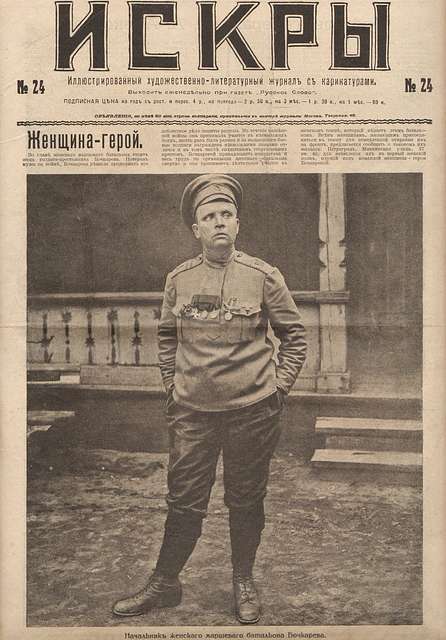Mariya Bochkareva and the Petrograd Women’s Death Battalion
“Since our men are hesitating to fight, the women must show them how to die for their country and for liberty.”
Last year, considerable attention was paid in the West to the 100th anniversary of the Russian Revolution, but much to my disappointment almost the entire emphasis in the media here was on the October Revolution. Having just published Caught in the Revolution: Petrograd 1917, I had long since come to appreciate that although October marked the point at which a new communist political order, led by Lenin, came to power, it was the earlier February Revolution that was far more significant in social historical terms.
There are many reasons why I favour a closer study of February in preference to the predicted and cynical Bolshevik takeover in October 1917. A huge amount has been written on the subject of October and I did not want to tread the same path as soon many other historians. No doubt this is because for me, as a feminist, the February revolution in Petrograd tells a far more interesting, but lesser known tale about women’s contribution to events that year.
International Women’s Day, Petrograd, 1917
After the February revolution, the women continued to lead the way. With mass desertion from the Eastern Front an increasing feature of Russia’s collapsing war effort, a woman named Mariya Bochkareva made it her mission that women should once more set an example. She was already a fighting solider and proud of her battle scars. After she had made a personal appeal to Nicholas II, the tsar had allowed Bochkareva to enlist in the reserve in 1915 and she had fought at the front where she had been wounded and decorated twice. In 1917, with the Russian Army – having already suffered 5.5 million casualties – in increasing disarray, Bochkareva resolved to set up her own Women’s Death Battalion. ‘Since our men are hesitating to fight,’ she argued, ‘the women must show them how to die for their country and for liberty.’ Soon after, she gained permission from the Justice Minister Alexander Kerensky to set up the first women’s battalion to counter the widespread loss of morale in the war.
In May, in Petrograd, Mariya Bochkareva held a mass recruitment rally at the Mariinsky Theatre. Mother Russia was suffering, she exhorted; it was down to the women to set an example. Fifteen hundred of them answered the call to arms and entered the selection process, which soon reduced their numbers by three-quarters.
Mariya Bochkareva, Mrs. Emmeline Pankhurst and women of the Battalion of Death, 1917.
Dorr, Rheta Louise Childe, 1872-1948, Public domain, via Wikimedia Commons
Training the Women’s Death Battalion
The Women’s Death Battalion was organized along similar lines to any male one: they had their own transport and medical staff, a signal corps and a machine gun company with four guns operated by the women. They even had their own scouting detachment of Cossack girls who were magnificent riders. They drilled hard, for six hours a day, like male recruits, and dug trenches.
Dressed in their army fatigues the Women’s Death Battalion were derided wherever they went – mainly by male Russian soldiers and deserters from the front, who jeered and humiliated them as they marched through the streets of Petrograd.
Volonteer “Women 1st Death Unit” of Russian Army of Mariya Bochkareva (Yashka). Petrograd. Summer 1917
See page for author, CC BY-SA 3.0, via Wikimedia Commons
American Journalists cover the story
Where else but Russia, ground down by three years of war and on the brink of a terrible and violent revolution, would women so heroically come to the fore? The establishment of Mariya Bochkareva’s extraordinary battalion of women aged between 18 and 30 – some of whom were married with children – was syndicated across the American press. About 60 percent of Bochkareva’s volunteers were of peasant stock or working girls from the factories with sturdy physiques. But their ranks were swelled by more ‘genteel’ women unused to the rigorous demands made on them: daughters of doctors, army officers and civil servants. Bochkareva’s second in command, Mariya Skrydlova, was an 18-year-old, convent-educated admiral’s daughter and by no means the only recruit from the comfortable bourgeoisie and upper classes. Several of the women had already served as nurses at the front or in Petrograd’s hospitals for the wounded. But, experienced or not, they all shared in a passion to support the Russian war effort, to bolster flagging morale and set an example to the many thousands of male recruits who by 1917 were deserting the front.
Russia’s Joan of Arc
In July 1917 Bochkareva’s women went into action at the front in Belorussia and fought with conspicuous courage, suffering 50 casualties. Among the wounded was Bochkareva herself. Brought back to Petrograd to recuperate, she was hailed as ‘Russia’s Joan of Arc’ by none other than Mrs Emmeline Pankhurst, the British suffragette who arrived in the city in June on a morale-boosting visit to Britain’s Russian wartime ally. Footage and photographs survive of Pankhurst inspecting the women alongside Mariya Bochkareva, whom she greatly admired.
From the beginning the women have been the soul and chief inspiration of the revolutionary movement. In some ways it owes more to them than to the men; the women had usually the higher ideal, the greater readiness for sacrifice, the more dogged and dauntless persistence.
Sadly Mariya Bochkareva, the loyal patriot, who urged women to play their part in the war effort, eventually became a victim of the Bolsheviks. Arrested under a false charge of being an ‘enemy of the working class’, she was shot by the Soviet secret police, the Cheka, in May 1920.






